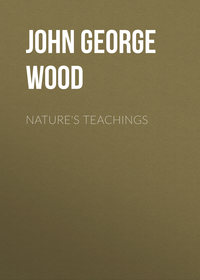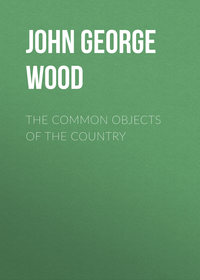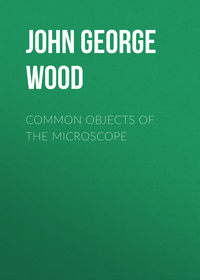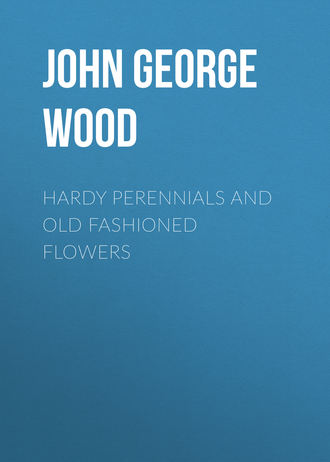 полная версия
полная версияHardy Perennials and Old Fashioned Flowers
Plants a year old are so easily raised from cuttings, and form such neat specimens, that a stock cannot be otherwise than very useful in any garden; besides, they lift so well that transplanting may be done at any time. My finest specimens have been grown from their cutting state, on a bed of sifted ashes liberally mixed with well-rotted stable manure; in such light material they have not only done well, but, when a few roots were required, they lifted large balls without leaving any fibre in the ground. To have good stout stock before winter sets in, slips should be taken from the old plants as soon as they have done flowering; dibble them into light but well enriched soil, and give water in droughty weather only.
I ought to mention that this dwarf Wallflower, and also its allied kinds, are capital subjects for very dry situations; on old walls and the tops of outhouses they not only do well, but prove decorative throughout the year. In such places plants will live to a great age, and sow their own seed freely besides.
Flowering period, May and June.
Chionodoxa Luciliæ
Snow Glory; Nat. Ord. LiliaceæA hardy bulbous perennial, from Asia Minor. It has only been cultivated about four years in English gardens; still it has been proved to be as hardy as the squills, which it very much resembles. Mr. Maw, who discovered and introduced it, found it "near the summit of the mountain," which (though it is a native of a much warmer climate than ours) may account for its hardy character. That it is a most beautiful flower is beyond doubt, but there are those who think it has been overpraised. It should not, however, be forgotten that Mr. Maw's description of it was from a sight of it in masses, a state in which it can hardly have been judged yet in this country, as until very recently the bulbs were very expensive. It has, however, taken kindly to our climate, and is likely to increase fast, when it may be seen to greater advantage.
It grows to the height of 6in. or 8in.; the flower scapes, which are rather slender, are somewhat shorter than the foliage, the flowers being longer in the petals than the squills, almost star-shaped, and nearly 1in. across; later on they reflex. Their colour is an intense blue, shading to white in the centre of the flower. The flowers are produced in numbers, from three to six on a stem, having slender pedicels, which cause the flowers to hang slightly bell fashion. The leaves, from their flaccidness and narrowness, compared with the squills, may be described as grassy. The bulbs are a little larger than the kernel of a cob nut, nearly round, having satiny skins or coats.
It may be grown in pots, and forces well if allowed first to make good roots, by being treated like the hyacinth. It should be kept very near the glass. It has also flowered fairly well in the open border fully exposed, but in a cold frame, plunged in sand and near the glass, it has been perfection. Single bulbs so grown in "sixties" pots have done the best by far.
All the bulbs hitherto experimented with have been newly imported; very different results may possibly be realised from "home-grown" bulbs. It is also probable that there may be varieties of this species, as not only have I noticed a great difference in the bulbs, but also in the flowers and the habit of plant. This I have mentioned to a keen observer, and he is of the same opinion; be that as it may, we have in this new plant a lovely companion to the later snowdrops, and though it much resembles the squills, it is not only sufficiently distinct from them, but an early bloomer, which we gladly welcome to our gardens. It seems to do well in equal parts of peat, loam, and sand, also in leaf soil and sand.
Flowering period, March and April.
Chrysanthemum
Nat. Ord. CompositæThe flowers to which I would now refer the reader are of no particular species, but, like several other genera, this genus has been considerably drawn upon or utilised by the hybridiser, and the species, looked upon from a florist's point of view, have been much improved upon by their offspring. Not only are Japan and China the homes of the finer flowering species, but in these countries the Chrysanthemum has been esteemed and highly cultivated for centuries; in fact, such a favourite is this flower with the Chinese, that they have treated it with many forms of their well-known art in matters horticultural, and when the flower was brought to this country it would doubtless be in a form improved by them. It reached this country nearly 100 years ago, and was known by the names C. indicum and C. sinense; about the same time a species from the East Indies was called C. indicum. This flower, from the time of its introduction, has been justly appreciated; and by the skill of several cultivators we have a largely increased number of forms and colours. Still, there are certain distinctions kept up amongst the varieties, and they are commonly known by such names as "large-flowering," "pompon, or small-flowered," "early flowering," "anemone-flowered," and "Japanese." These names, besides being somewhat descriptive, are otherwise useful to the amateur who may wish to grow a representative collection, and where there is convenience it is desirable to do so in order to observe their widely different forms and colours, as well as to enjoy a long succession of bloom.
So well is the Chrysanthemum known that little could be usefully said of it by way of description; but well as it is known and easy as its culture is, there are few things in our gardens that show to greater disadvantage. This should not be with a subject which offers such range of habit, colour, and period of blooming; and when such is the case, there must be some radical mistake made. The mistake I believe to be in the selection, and that alone. If so, the remedy is an easy matter. Let me ask the reader to remember three facts: (1) Many sorts grown in pots and flowered under glass are unfitted for the borders or open garden. (2) The later flowering varieties are of no use whatever for outside bloom. (3) Of the early blooming section, not only may the finest varieties be grown with marked effect, but they, as a rule, are of more dwarf habit, and will afford abundance of bloom for cutting purposes for nearly two months. Selections are too often made from seeing the fine sorts in pots; let it be understood that all are perfectly hardy, but owing to their lateness, their utility can only be realised under artificial conditions. I am not now considering pot, but garden kinds, and no matter what other rules may be observed, if this is overlooked it will be found that though the plant may grow finely and set buds in plenty, they will be so late as to perish in their greenness by the early frosts; on the other hand, of the early section, some will begin to bloom in August, and others later, each kind, after being covered with flowers for several weeks, seeming to finish naturally with our season of flowers.
There is nothing special about the culture of this very hardy and rampant-growing plant, but I may add that, though it will stand for many years in one place, and flower well too, it is vastly improved by division of the roots in autumn or early spring every second year. The earth of its new site should be deeply dug and well enriched with stable manure; it will not then matter much what sort of soil it is—the more open the situation the better. How grandly these decorate the borders when in masses! and as a cut flower I need hardly say that there are few to excel the Chrysanthemum, either as an individual bloom or for bouquet and other work.
I do not frequently make mention of many florists' flowers by name, but in this case I think I may usefully name a few varieties: Andromeda, cream coloured, Sept.; Captain Nemo, rosy purple, Aug.; Cassy, pink and white, Oct.; Cromatella, orange and brown, Sept.; Delphine Caboche, reddish mauve, Aug.; Golden Button, small canary yellow, Aug.; Illustration, soft pink to white, Aug.; Jardin des Plantes, white, Sept.; La Petite Marie, white, good, Aug.; Madame Pecoul, large, light rose, Aug.; Mexico, white, Oct.; Nanum, large, creamy blush, Aug.; Précocité, large, orange, Sept.; Sœur Melaine, French white, Oct.; St. Mary, very beautiful, white, Sept. These, it will be seen, are likely to afford a variety and succession of bloom.
Flowering period, August to November.
Cichorium Intybus
Syns. C. Perenne and C. Sylvestre—Wild Succory or Chicory; Nat. Ord. CompositæThis herbaceous perennial is a native plant, in many parts being very common. Not only, however, do many not know it as a wild flower, but we have the facts that under cultivation it is a distinct and showy plant, and that of late it has come into great request. Its flowers are a pleasing blue, and produced on ample branches, and for mixing with other "old-fashioned" kinds, either in the borders or as cut blooms, they are decidedly telling; for blending with other Composites it has its value mainly from the fact that blues are rare in September; the China asters are too short in the stalk for cutting purposes, and many of the tall perennial starworts are neither bright nor well disposed. I may also mention another proof of its decorative quality—it is not common (i.e., wild) in my district, and a plant being cultivated in my garden for its flowers has been so much admired that it is likely to have other patrons, and in many instances it is being introduced into gardens where the choicest flowers are cultivated. I am bound, however, to say that when not in flower it has the appearance of the commonest weed.
Its flowers are produced when 2ft. to 6ft. high. They are of a fine glistening blue colour, 1in. to 1½in. across, and in the way of a dandelion flower, but stalkless individually, being disposed in ones, twos, and threes, somewhat distantly in the axils of the leaves, and all over the numerous and straggling branches. The leaves are rough, of a dingy green colour, and variously shaped, Gerarde's description being as follows: "Wilde Succori hath long leaues, somewhat snipt about the edges like the leaues of sow thistle, with a stalke growing to the height of two cubits, which is deuided towarde the top into many braunches. The flowers grow at the top blewe of colour; the roote is tough and woodie, with many strings fastened thereto."
I find this plant not only enjoys a half shady place, but if it is so placed that its quick growing branches can mix with those of other subjects in a trellis or other supports, its coarser parts will not only be partially hidden, but the rich coloured flowers will show to advantage. I may mention that mine is mixed with Virginian creeper on wires, and the effect may easily be imagined. It will do in any kind of garden soil, but if deeply dug and well manured the flowers are vastly improved. Propagated by seed or division of the stout tap roots.
Flowering period, August to September.
Clethra Alnifolia
Alder-leaved Clethra; Nat. Ord. EricaceæA hardy deciduous shrub, and mentioned in connection with herbaceous perennials because of its rich flowers and dwarf habit. It is a native of North America, having been grown in this country for 150 years; it is not so often met with as it ought to be, though much esteemed. It becomes very productive of flowers when only 2ft. high, but grows somewhat taller when well established; it is more valuable than common from its floriferousness, during late summer to the end of the season.
Let me at once state that its winning point is the delicious scent of its pure white flowers; it is very powerful, and like that of the lilac and alder combined; the racemes are 2in. or 3in. long, and compactly formed of short-stalked flowers less than ½in. across; they are of good substance, and in form resemble the lilac flower minus the tube; the flower stems are somewhat woody, and foliaged to the base of the spike or raceme. The leaves are of varying sizes, oval, lance-shaped, and short-stalked, distinctly veined and slightly wrinkled, sharp but finely toothed, of a dark shining green colour on the upper and a greyish-green on the under side. The whole shrub is somewhat rough to the touch; the habit is bushy and branching, increasing in size from suckers; the numerous twiggy side shoots of the previous year's growth produce the flowers.
It enjoys a light soil and sunny situation, and it may be planted anywhere in the shrubbery or borders as a first-class flowering subject. Its scent loads the air for some distance around, and pleasantly reminds one of spring flowers. Such sweet-smelling flowers are not too plentiful in September, and I know not a better one than this amongst hardy flowers for the late season. Its odour is fine and full; a single sprig now by me proves almost too much for the confinement of a room. This quality is invaluable in small flowers that can be freely cut, which, moreover, as in this case, are otherwise suitable for bouquet work. Propagated by cuttings and division of the suckers, taken when growth has ceased; if put in sandy loam and a warm situation, they will become rooted during the following spring.
Flowering period, August and September.
Colchicum Autumnale
Meadow Saffron; Common Name, Autumnal Crocus; Nat. Ord. MelanthaceæA native bulbous perennial (see Fig. 25). The Colchicums are often confounded with the autumn-flowering species of croci, which they much resemble when in bloom; the similarity is the more marked by the absence, from both, of their leaves in that season, otherwise the leaves would prove to be the clearest mark of difference. Botanically they are far removed from each other, being of different orders, but there is no need to go into such distinctions, not, at any rate, in this case.

Fig. 25. Colchicum Autumnale
(about one-sixth natural size.)
The flowers are well known and they need not be described further than by saying they are in form crocus-like, but much longer in the tubes and of a bright mauve-purple colour. The bulbs have no resemblance to the crocus whatever, being often four times the size of the crocus corms. Moreover, they are pear-shaped and covered with flaky wrappers of a chestnut brown colour; if examined, these coverings will be found, near the neck of the bulb, to be very numerous and slack fitting, extending above the ground, where they have the form of decayed or blackened foliage; a singular fact in connection with the roots is, they are not emitted from the base of the bulb, but from the side of the thickened or ovate part, and are short and tufty. In early spring the leaves, which are somewhat like the daffodil, but much broader and sheathed, are quickly grown; at the same time the fruit appears. In summer the foliage suddenly turns brown, and in the autumn nothing is seen but blackened foliage, which is very persistent, and which, a little later, acts as sheaths for the long-tubed flowers. Unless the weather be very unfavourable, these flowers last a long time—fully two weeks. The double variety, which is somewhat scarce, is even more lasting, and I may add, it is a form and colour so softly and richly shaded that it is nothing short of exquisite; but the single variety, now more especially under notice, is also capable of agreeably surprising its friends when used in certain ways, for instance, as follows: A tray of the bright green and nearly transparent selaginella, so common in all greenhouses, should form the ground for twos or threes of these simple but elegant Saffron flowers; no other should be placed near—their simplicity forms their charm. It will be seen that the robust but soft-coloured flower of the meadows harmonises finely with the more delicately grown moss. In other ways this fine autumnal flower may be used with pleasing effect in a cut state, and it blends well with the more choice exotics. This is more than can be said of many hardy flowers, and it is fortunate that during dull weather, when we are driven from our gardens, there are still some flowers which may be hastily gathered and so arranged indoors as to give us all the pleasure which only such flowers can yield at such a season.
I find this subject to do well in any situation, but I think the blooms are a richer colour if grown under partial shade. The bulbs should not be disturbed if abundance of flowers are wanted; but if it is found desirable to propagate them, the bulbs may be lifted every two or three years, when the tops have withered, and when there will probably be found a goodly crop of young tubers.
Flowering period, September and October.
Colchicum Variegatum
Nat. Ord. MelanthaceæThis comes from Greece, nevertheless it is perfectly hardy; it is not only peculiarly pretty when closely examined, but a truly handsome flower, either as cut bloom or seen in groups in a growing state. Compared with C. autumnale, it is shorter in the tube, or more dwarf; still, it is a larger flower, and its rosy purple petals, or divisions of the corolla, are more spear-shaped, and each from 2in. to 3in. long; they have a stout and almost white mid-rib, the other parts of the segments being distinctly and beautifully chequered with white and rosy purple; the tube is stout, and of transparent whiteness; the foliage less than that of the British species, and more wavy. The habit of the flowers is erect, and during sunshine they become flatly expanded, when they will be 4in. to 5in. across, being 3in. to 4in. high. It is a very durable flower, lasting at least a fortnight, and many are produced from one bulb, appearing in succession, so that the blooming period is well extended; it braves the worst weather with little or no damage. Unlike the longer-tubed varieties, it is never seen in a broken state, and it is this which mainly renders it superior. Either as a cut flower, or a decorative subject for the borders or rockwork, it is a first-rate plant, being neat and showy.
It enjoys a sandy loam in a moist but warm situation; at the base of a small rockwork having a southern aspect it flourishes to perfection; it can hardly be planted wrongly provided there is no stagnant moisture. Propagated like C. autumnale, than which it is of slower increase.
Flowering period, September and October.
Coreopsis Auriculata
Ear-leaved Coreopsis; Nat. Ord. Compositæ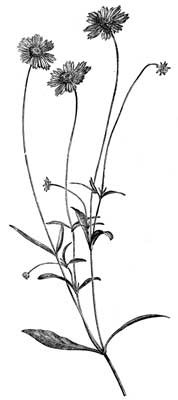
Fig. 26. Coreopsis Auriculata.
(one-fourth natural size.)
The oldest species of the genus grown in English gardens; its flowers are yellow, but dotted at the base of the ray florets. The leaves, as implied by the name, are dissimilar to other species, being lobed and having ear-like appendages; but this feature is far from constant, and otherwise the leaves differ, being sub-sessile and oval-lance-shaped (see Fig. 26). It came from North America as long ago as 1699. Slugs are very fond of these plants, and in winter more especially, when the dormant eyes are not only in a green, but exposed state; they should be watched after, or during one mild night the whole may be grazed off, to the great injury of the plant.
Its habit, uses, culture, and propagation are the same as for C. tenuifolia.
Coreopsis Grandiflora
Large-flowered Coreopsis; Nat. Ord. CompositæIn many parts this resembles C. lanceolata, its main distinction being implied by its name. The flowers are larger and the ray florets more deeply cut; it is also bolder in the foliage, and the stems grow nearly as strong as willows. It is an abundant bloomer, and a good specimen is a glorious object during the autumn. It comes from North America, but my experience of it is that it is not so hardy as C. lanceolata and C. auriculata.
Habit, uses, culture, and propagation, as for C. lanceolata.
Coreopsis Lanceolata
Spear-leaved Coreopsis; Nat. Ord. CompositæThis form of bright yellow flower is in great favour during August, but that is not all. The various kinds of this genus are plants of the easiest culture, and their rich flowers are produced in great quantities from midsummer to the time the frosts begin. This species has been said to be only of a biennial character; it is, however, understood generally to be perennial, though not quite so hardy as others which come from the colder climates of America. It was imported from Carolina in 1724, and in this country proves hardy in selected situations, where its roots are comparatively dry in winter, and I may add that it proves a true perennial.
When the plant has attained the height of a foot it begins to flower; each bloom has a long pedicel, nearly naked, also round and smooth. The flowers are a shining yellow colour, and nearly 3in. across; the florets of the ray are flatly arranged, shield-shaped, pleated, and four-toothed, the teeth being sometimes jagged; the disk is small for so large a flower; the florets brown and yellow. The double involucrum, common to the genus, has its upper set of bracteoles rolled outward; they are of a brownish colour; the lower set are green and wheel-shaped during the period of a perfect ray, and they alternate with the upper ones. The leaves, as may be inferred from the specific name, are lance-shaped, 2in. to 6in. long, smooth and entire; they are attenuated to the stems, which they more or less clasp. The habit of the plant is much branched, but only slightly at base; it becomes top-heavy from the numerous shoots near the top, which cause it to be procumbent; otherwise this subject would rank with tall growers. It is one of the most useful flowers, both, in the garden and when cut, the long stalks in both cases adding much to its effectiveness; its form and brightness are sure to commend it, no matter whether it happens to be a fashionable flower or otherwise. It is at once a bold and delicate form, and one that harmonises with any other kinds and colours.
It should be grown in deeply-dug and well-enriched earth, and, as already hinted, the drier the situation the more safely will it winter. Not only that, but on raised beds or banks sloping to the full sunshine it will also flower to perfection. All its family, so far as I have proved them, hate excessive moisture. Its propagation may be by division, as in this damp climate it does not seem to ripen seed, but I have found sometimes not a little difficulty in dividing the woody roots, as frequently there is only one stem below the surface with roots. When there are more the difficulty is lessened, but I have noticed that the stronger branches which are weighted to the ground form rudimentary roots where in contact with the earth. These may either be pegged and covered with soil, or cut off and made into cuttings, removing most of the tops. If the latter is done during August they will become well rooted before the frosts appear.
Flowering period, July to October.
Coreopsis Tenuifolia
Slender-leaved Coreopsis; Nat. Ord. CompositæHardy, herbaceous, and perennial; a native of North America, and a distinct species, from its finely-cut foliage and small, dark, orange-yellow flowers. For several weeks it has a few flowers, but during September it literally covers itself with bloom, so that it is one of the most pleasing objects in the garden.
It grows 2 ft. high; each flower has a long nearly nude stalk, slender but wiry; the flowers are 1½in. across, and of a deep yellow colour; the florets of the ray are more distant from each other than is the case with many of the genus; the disk is small, dark brown, but changing from the appearance and disappearance of the yellow seed organs. The foliage, as may be seen by the illustration (Fig. 27), is deeply and finely cut, of a dark green colour, and so arranged that each node has a nearly uniform dressing; the main stems are slender, and bend gracefully with the least breeze, and otherwise this plant proves a lively subject. Its habit is bushy and very floriferous, and it is well worth a place in every garden. It cannot fail to win admiration; even when growing, and before the flowers appear, it is a refreshing plant to look upon. In a cut state, the bloom, if taken with long stems, is well adapted for relieving large and more formal kinds. Tastes differ, and in, perhaps, nothing more than floral decorations; all tastes have a right to a share of indulgence, and in claiming my privilege in the use of this flower, I should place two or three sprays (stems) alone in a glass or bright vase, but there might be added a spike of the cardinal flower or a pair of single dahlias and a falling spray of the Flame nasturtium (Tropæolum speciosum).





